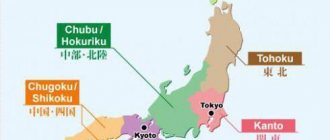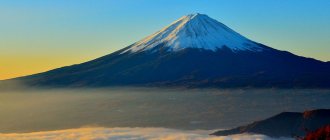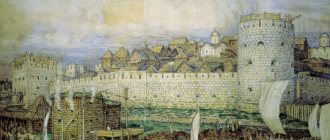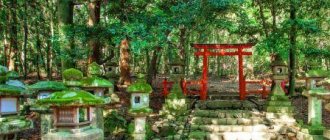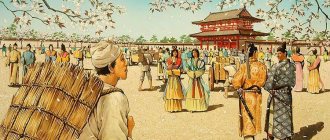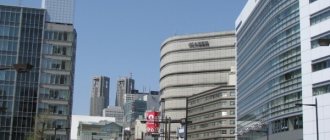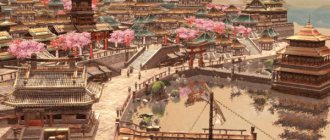Cities of Japan in Russian
| City (special areas of Tokyo) | Population | Square | Attractions |
| Tokyo | 8637098 | 621.81 |
|
| Kochi | 342944 | 309.22 |
|
| Yamagata | 255370 | 381.34 |
|
| Hiroshima | 1163806 | 905.13 |
|
| Himeji | 536170 | 534.27 |
|
| Fukuoka | 1430371 | 340.96 |
|
| Fukui | 268574 | 536.17 |
|
| Toyama | 421116 | 1241.85 |
|
| Shizuoka | 710944 | 1388.78 |
|
| Sendai | 1029552 | 783.54 |
|
| Osaka | 2668586 | 222.30 |
|
| Niigata | 813053 | 726.10 |
|
| Nagasaki | 448792 | 406.37 |
|
| Morioka | 299746 | 886.47 |
|
| Mito | 264062 | 217.43 |
|
| Matsue | 195875 | 530.27 |
|
| Kurume | 305147 | 229.84 |
|
| Kumamoto | 670348 | 267.23 |
|
| Kobe | 1530847 | 552.23 |
|
| Kyoto | 1474570 | 827.90 |
|
| Kagoshima | 605196 | 547.06 |
|
| Yokohama | 3697894 | 437.38 |
|
| Wakayama | 372175 | 209.23 |
|
| Akita | 329287 | 905.67 |
|
| Okayama | 701293 | 789.91 |
|
| Tottori | 200315 | 765.66 |
|
| Tokushima | 266370 | 191.39 |
|
| Nagoya | 2283289 | 326.45 |
|
| Matsuyama | 515068 | 429.03 |
|
| Maebashi | 318058 | 241.22 |
|
Sendai
Sendai city in Japan
Annual festival in Sendai city
One of the most famous festivals in the country is held here. Every year, the leafy streets of Sendai are filled with people who come to enjoy the Tanabata Matsuri. Located in the Tojuco region, it is the largest city in the area and offers a taste of local culture. Many travelers stop here on their way to the nearby wilderness.
With a vibrant nightlife and a vibrant landmark - a charming ruined castle with beautiful gardens - Sendai is a pleasant place to visit and an even nicer place to live. From here you can also head to the nearby hot springs or Matsushima, which offers some of the best views in Japan.
Top 10 largest cities in Japan
Cities in Japan with a population of more than 1,000,000 people cover an area of 6,372 km2. The 10 largest urban districts are home to 25% of the country's population. They house the headquarters of international banks and multinational corporations. These cities are the administrative centers of Japanese prefectures and important transport hubs.
Saitama
The city of Saitama is the capital of the prefecture of the same name, located in western Japan. It is part of Greater Tokyo and covers an area of 217 km2. Saitama combines 3 settlements: Urawa, Omiya and Yono. Saitama consists of 10 districts.
It is connected to the capital of Japan by roads and railways. Narita International Airport is located 200 km from the city. For regional transportation, Honda Airport was built near Saitama. After the World Cup, a subway line called the Saitama Railway was built in the city.
Saitama hosts many sporting events. Friendly football matches are regularly held at the Saitama 2002 stadium. Mixed martial arts and figure skating competitions are also organized here.
The Chichibu Yomatsuri Festival is held in Saitama. It is recognized as a cultural heritage site. During the festival, a parade takes place in the city. Locals stroll through the central areas accompanied by traditional music and pass through 6 platforms with halberds.
Kawasaki
Kawasaki is a city located in the north of Kanagawa Prefecture. It is part of the Keihin Industrial Belt industrial zone.
The following enterprises are located in the city:
- Thermal power plants.
- Oil refineries.
- Shipyards.
- Chemical production.
- Steel rolling factories.
- Machine-building factories.
The Tama River flows along Kawasaki, which is one of the main transport hubs in the region. The city also has a seaport for servicing merchant ships.
The city of Kawasaki has many traditional Japanese houses built in the 19th century. Water mills have been preserved here. In the center of Kawasaki there is a zoo where endemic animals live. The Kanamara Matsuri festival is held annually in Kawasaki.
Fukuoka
Fukuoka is the capital of the prefecture of the same name, located in southern Japan. It was founded at the end of the 19th century and covers an area of 340 km2. The city is located on the shores of the Sea of Japan. For this reason, it is one of the most important trading hubs in Japan.
For many decades, traders from various Asian countries settled in Fukuoka. As a result, many national neighborhoods with unique architecture appeared here.
Fukuoka has a developed sports infrastructure. This city has many baseball and football clubs. Sumo, long-distance running and judo competitions are often held in the city district. Fukuoka hosted the World Aquatics Championships and the Summer Universiade.
Kyoto
The cities of Japan attract a large number of travelers with their unique architecture, Shinto shrines, imperial palaces and Japanese gardens. The largest number of these buildings have been preserved in Kyoto, the former capital of Japan.
This city was founded in the 8th century and covers an area of 827 km2. Historically, Kyoto has been an important transport hub. Kyoto Station handles 100 trade and passenger trains daily. The city has developed public transport. Bus routes allow tourists to reach the most remote suburbs without congestion.
In the 1960s The first metro lines and monorail were built here. The city operates a tourist railway, allowing travelers to visit the main attractions of the former capital of Japan.
Kyoto is the cultural center of Japan. There are 2000 temples and sanctuaries here. The city has preserved geisha quarters. Tourists are offered excursions to the residences of the shoguns and the ancient quarters of the city. The city hosts the Aoi Matsuri and Gion Matsuri festivals.
Kobe
Kobe City is the capital of Hyogo Prefecture. It is included in the list of the largest port cities in the world. Kobe has factories for the production of household appliances, transport equipment, machine tools, communication devices and food products.
The following corporations have offices in Kobe:
- Kawasaki Heavy Industries.
- Sun Television.
- Kobe Steel.
- Fujitsu Ten.
Kobe is served by high speed train lines, including the Shinkansen. The city has a metro and many highways. Next to it is the 3rd largest airport in the Kansai region.
Sapporo
Sapporo is the capital of Hokkaido Prefecture, located in northern Japan. It was founded in 1868 and covers an area of 1,121 km2. This city has a developed sports structure. Due to the special climatic conditions, there are many ski slopes and jumps on its territory.
In winter, the Snow Festival is held here, where sculptures made of snow and ice are demonstrated. Much of the winter sports infrastructure was built during the 1972 Olympic Games.
Nagoya
Nagoya is the capital of Aichi Prefecture. The Central Japanese Commodity Exchange is located on its territory. Nagoya has a developed mechanical engineering industry. The headquarters of Japan's largest automakers, including Toyota, Nissan and Honda, are located here. There are also oil refining, textile and light industry enterprises in the city.
Nagoya State University is the largest educational institution in central Japan. Many Nobel Prize laureates studied there.
Nagoya is home to 22 higher education institutions. Nagoya has a developed transport system. The city has a metro and a network of city buses. The center of Nagoya is connected to the suburbs by train lines. This city is connected to the rest of Japan via air travel. Chubu International Airport is located here.
Osaka
Osaka is the 3rd city in Japan by population. It features modern architecture and a large number of nightclubs and restaurants. There are many samurai castles, Shinto shrines and Buddhist temples founded in the 8th century.
Osaka has one of the largest metropolitan areas in the world. Every year it serves over 900 million passengers. The city has 2 international airports located on artificial islands.
Yokohama
Yokohama is the second most populous city in Japan. It is a major shipbuilding center. There are a large number of factories producing military and cargo ships here. The city has factories producing semiconductor products and biotechnological products.
Yokohama has preserved buildings from Japan's modernization era. There are a large number of churches and cathedrals located in the city. The buildings are made in European style. Yokohama has historically had a large foreign population. Therefore, national areas with unique architecture were formed here.
Tokyo
Tokyo is the capital and largest economic center of the country. More than 11 million people live on its territory. The headquarters of foreign corporations and banks are located here. For this reason, a large number of foreigners live in Tokyo.
The city is home to many industrial enterprises that worsen the environment.
The central part of Tokyo is lined with neon-lit skyscrapers. Here tourists can get acquainted with the modern culture of Japan: anime, manga and computer games. In the suburbs you can see many Shinto and Buddhist temples. The city is home to Japan's largest art galleries and museums.
Yokohama
Yokohama
Yokohama city in Japan
Even though Yokohama is less than half an hour from Tokyo, it certainly has its own personality and, as Japan's second largest city, is worth a visit. Situated on the shores of a beautiful bay, it is a vibrantly cosmopolitan city, as evidenced by its large expatriate community, wealth of different architectural styles and delicious cuisine from around the world.
Kanazawa
Situated on the Sea of Japan, with an abundance of beautiful temples, ancient shrines and many fantastic museums, this charming city is not to be missed. The beautifully preserved ancient areas are perfect for strolling. Be sure to visit the areas of geishas and samurai, which are hundreds of years old. These are truly historical places.
In fact, Kanazawa rivals Kyoto in terms of cultural attractions, although the Japanese themselves rarely visit the city. The highlight of Kanazawa is undoubtedly Kenroku-en, an impressive castle with lush gardens.
Nagasaki
Population ≈ 513 thousand
Another city in Japan that was subjected to atomic bombing by the United States in August 1945. But hardworking residents rebuilt their city, and today it is one of the most beautiful in the country.
Today, a little more than 513 thousand people live in Nagasaki, and in the area where the epicenter of the explosion was, there is now a calm, peaceful suburb of one-story Japan.
“Long Cape,” as the name of the city is translated from Japanese, was founded in 1579. It is noteworthy that this eastern city has the largest number of Christians.
Osaka
Population ≈ 2.67 million
In the southern part of the island of Honshu, on the beautiful shore of Osaka Bay, lies the city of the same name. In 596-654 the town was the capital and the imperial palace was located here.
During the Middle Ages, the port city was an important trading center through which goods were distributed to all the islands and regions of Asia. In 1956, Osaka became a city and the center of a prefecture by a separate decree.
There are many attractions within the neighborhoods, including the famous Buddhist temples of Isshin-ji and the oldest Shitenno-ji temple. The population fluctuated in the 20th century due to frequent earthquakes, but now it is the third largest city in terms of the number of inhabitants.
2
Fukuoka
Population ≈ 1.43 million
The history of the modern city began with the small port of Na. The port directly accessed the Sea of Japan, and therefore became an important center of trade with Korea and China. The territories developed and the city increased significantly in size. In addition to the Japanese, Chinese and Korean traders lived here. But after the severance of relations with the mainland, the city lost its former significance. In 1972, Fukuoka became a city divided into districts.
The city has several symbols, including the sea gull, since the neighborhoods directly face the sea coast. Here, one of the tallest coastal Japanese skyscrapers, Fukuoka Tower, soars into the sky.
7
Nagano
Population ≈ 378 thousand
In the very center of the Japanese island of Honshu lies the beautiful city of Nagano, whose history dates back to April 1, 1897.
A relatively small city with a population of 378 thousand inhabitants. Among the attractions, a large Buddhist center stands out, and around the city there are picturesque mountain landscapes and a beautiful river valley.
There is also a unique park of Jigokudani monkeys, who live near thermal springs. Like Sapporo, Nagano was lucky enough to host the 1998 Winter Olympics.
13
Nagoya
Population ≈ 2.28 million
Archaeological research has confirmed that sites on the site of the modern city appeared during the Upper Paleolithic. Already in the 1st millennium it was a densely populated area of the Japanese islands.
The symbol of the city is interesting. This is the hieroglyph for "8" that is enclosed in a circle. Symbolism in infinity. The number eight is a symbol of infinity throughout the world, as well as a circle that has no beginning or end. This symbolizes the endless development of the Japanese city.
For more than half a century, Nagoya has firmly ranked fourth in terms of population among the largest cities in the Land of the Rising Sun.
3
Sapporo
Sapporo
Sapporo city in Japan
The capital of Hokkaido, Sapporo is a tranquil travel destination with all the trappings of a typical Japanese city. While most people view it as a stopover on the way to the island's stunning mountains and hot springs, the city itself has more than enough to keep guests entertained with fantastic restaurants, giant shopping malls and a vibrant nightlife. .
While people often visit during the summer, when Sapporo hosts a number of great festivals, the highlight of the year is the famous Snow Festival, when crowds of tourists flock to the city to see the amazing ice and snow sculptures.
Kawasaki
Population ≈ 1.37 million
To the southwest of the Japanese capital lie the multi-storey neighborhoods and traditional houses of the city of Kawasaki. The settlement is known all over the world by the name of the corporation of the same name, which produces excellent motor vehicles.
Kawasaki plays an important role in the transport system of Japan, so a deep-water port was built here. The city itself is divided into seven districts, and the historical part is full of attractions of a secular and religious nature.
It is noteworthy that the city with a large number of residents does not have a metro system. And the reason is that Kawasaki is located on the ocean, and therefore groundwater simply does not allow the creation of deep stations.
8
Ise is the most important religious center of the country
The town is located 300 km from the capital of the state. Here is the most important religious center of the country, an object of mass pilgrimage, a repository of Shinto treasures, represented by ancient, great shrines, closely connected with the history, cultural, and spiritual life of the Japanese people. The local nature, dense green hills and forests amaze the eye.
Ise-Jingu Shrine is a very popular shrine all over the world. In Japan, every resident knows about it. It consists of two groups of temples - external Naiku and internal Geku, dedicated to the goddess Amaterasu. In addition to the temple, guests and tourists visit the museum of fine arts, history, agricultural museum, and library. All of them are part of the sanctuary.
A famous place is the town's historical district - Kawasaki, located along the Setagawa River. The area was once an important trading place, hosting more than a million pilgrims a year to Ise-Jingu Shrine. Ships entered the town along the river. Today, only the main street has been preserved, where you can buy various souvenirs and much more.
Nara
The city of Nara is located in the north of Nara Prefecture. In Nara, where the capital of Japan was founded in 710, many historical buildings and streets have been preserved. Heijo Palace, which served as the residence of the Emperor and the workplace of government officials, is now open to visitors as one of the historical monuments of Eijō-kyū. The area around Heijo Palace became a city, and the old houses of artisans and merchants remain a tourist site known as the "Naramachi District".
Along with the historical buildings, another symbol of the city of Nara is its deer. Nara Park, adjacent to Kasuga-taisha Shrine and designated as an Important National Cultural Site, is home to approximately 1,500 wild deer (as of 2015). Food for deer can be purchased within the park, and visitors are allowed to get up close and interact with these animals.
Kyoto is synonymous with traditional Japanese culture
For more than a thousand years, the historical center of the country was concentrated here. Kyoto was the capital of Japan from 794 to 1869. The metropolis is located in the center of the island of Honshu, the old name of the city is Heian. Kyoto is founded in the form of an elongated rectangle; the layout of streets, blocks, and squares is regular and symmetrical. World famous poets, artists, and writers were born here. Many ancient buildings and places of cultural heritage have been preserved in Kyoto, in particular the Imperial Palace, which can be visited as part of a tour. Some city streets are listed as World Heritage Sites.
The national center of traditional practices of chado (tea ceremony) and ikebana (flower arranging) is located here. This is the birthplace of kabuki, a leading center of calligraphy, sculpture, and painting.
It is definitely worth visiting such historically memorable places as the Kyoto Gosho Imperial Palace, where the coronation ceremony of the new emperor of Japan, rituals, important state ceremonies are held, the Kyoto Imperial Residence, the imperial villas of Shugakuin, Katsura. They can only be visited by people over 18 years of age; they must present a passport at the entrance.
Other noteworthy places in the city:
- Nijo Castle;
- Ryoan-Ji Temple;
- Sanjusangendo Temple;
- Fushimi Inari Taisha Shrine;
- bamboo forest;
- Diakaku-ji Temple;
- Gion district;
- philosophical path;
- Buddhist Temple of Pure Water;
- Silver Pavilion;
- Golden Pavilion;
- Kyoto Gardens.
Hiroshima
Population ≈ 1.199 million
The settlement of the territories of modern Hiroshima began approximately 300 years before the beginning of our era, and in 1589, by order of Terumoto, a beautiful castle was built here.
A settlement arose near the castle, which was named Hiroshima, which means “Wide Island”. Off the coast of the city, right in the water, there is a unique landmark of the Shinto religion - the Torii of Itsukushima Shrine.
The city had to endure a terrible tragedy when the Americans dropped a nuclear bomb on it.
10
Tokyo
Tokyo
Night Tokyo (Tokyo).
Japan Situated in the heart of the most populous place in the world, Tokyo has just under forty million people living in this metropolis. Therefore, there really is something to enjoy here. Straight out of a sci-fi movie, the city's dazzling array of neon-lit skyscrapers is mesmerizing. And at night they look even more impressive.
While Tokyo is definitely a modern, thriving city that promotes its unique pop culture and fashion sense to the world, remnants of the historical city still remain. You can stroll peacefully along the cobbled streets and find atmospheric old-style bars and street food stalls. And by the way, this city actually has more Michelin-starred establishments than anywhere else in the world, and the food here is sumptuous.
Whether it's wandering through the huge shopping malls or exploring the different districts - each with its own atmosphere and personality - it will take a lifetime to see all that Tokyo has to offer.
Kobe
Population ≈ 1.53 million
For the first time, a settlement in the historical province of Inzumi was mentioned in an ancient treatise of 201. In the Middle Ages and Modern times, it was the largest port through which goods passed to Kyoto.
Today the port is also of great importance in the economic life of Japan. Even the emblem of the city is two crossed fans, meaning two large ports. The headquarters of the largest Japanese companies are located here, and the most beautiful attraction is the Akashi-Kaikyo Bridge, built over the waters of Akashi Bay.
At one time, the Ikuta sanctuary was created here, and the name of the city comes from the name of the ministers who perform rituals in the sacred place.
5

